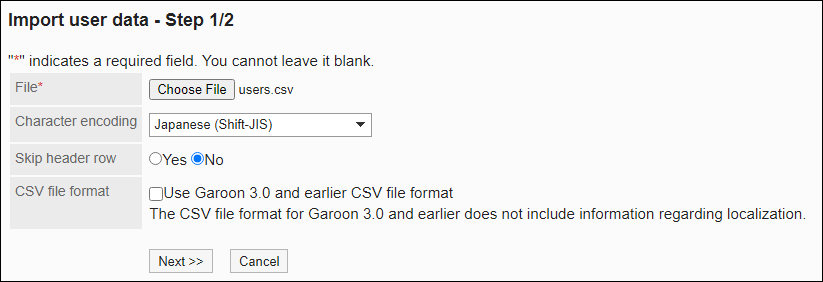Managing Organizations, Users, and Roles in a CSV File
You can manage data for users, organizations, and roles in CSV files.
The following data can be managed using CSV files:
- Organization
- Organization details
- Organization member data
- Organization name data
- Users
- User profile
- Membership information data
- Role data by user
- Role
- Role details
- User data by role
Importing Data from a CSV File
You can import organization, user, and role data from CSV files.
If an error occurs while importing a CSV file, the import process will be terminated. The data which has been imported will be eliminated.
-
Create a CSV file to import data.
For information on items that can be managed in CSV files, see the "Organizations/Users/Roles" section. -
Click the administration menu icon (gear icon) in the header.
-
Click System settings.
-
Select "Basic system administration" tab.
-
Click Users.
-
Click Import from CSV file.
-
On "Import from CSV File" screen, select the data to import.
-
Select the CSV file that you created in step 1.
-
Set the data to import, and click Next.
The setting fields are as follows:
- Character encoding:
Encodes data from a CSV file with the selected character code.
The following character encoding can be selected:- Unicode (UTF-8)
- Japanese (Shift-JIS)
- ASCII
- English (Latin1)
- Simplified Chinese (GBK/GB2312)
- Thai (TIS-620)
- Skip the first row:
If the header row contains information other than the data such as an item name and a comment, select "Yes". - CSV File Format:
This field is displayed when you import user information.
Select whether to use the version 3.0 or earlier format.
If you use version 3.0 or earlier, you cannot import information about localization.

- Character encoding:
-
Confirm the CSV file contents and click Import.
Exporting Data to a CSV File
You can export organization data, user data, and role data to a CSV file.
-
Click the administration menu icon (gear icon) in the header.
-
Click System settings.
-
Select "Basic system administration" tab.
-
Click Users.
-
Click Export to CSV file.
-
On the "Export to CSV File" screen, select the data to export.
-
Set the required items for the data to export.
The setting fields are as follows:
- Character encoding:
Select the character code that you want to use for encoding.
The following character encoding can be selected:- Unicode (UTF-8)
You can select with BOM as required. - Japanese (Shift-JIS)
- ASCII
- English (Latin1)
- Simplified Chinese (GBK/GB2312)
- Thai (TIS-620)
- Unicode (UTF-8)
- Include header row:
To export an item name to the header row of a CSV file, select "Yes". - Language in which the data is exported:
This field is displayed when you export an organization name.
Set the language in which you want to export an organization name. You can set multiple languages.
The following languages can be selected:- All
- 日本語
- English
- 中文(简体)
- 中文(繁體)
Exported in Traditional Chinese.
- CSV File Format:
This field is displayed when you import user information.
Select whether to use the version 3.0 or earlier format.
If you use version 3.0 or earlier, you cannot export information about localization.

- Character encoding:
-
Confirm your settings and click Export.
-
Save the file with a function provided by your Web browser.